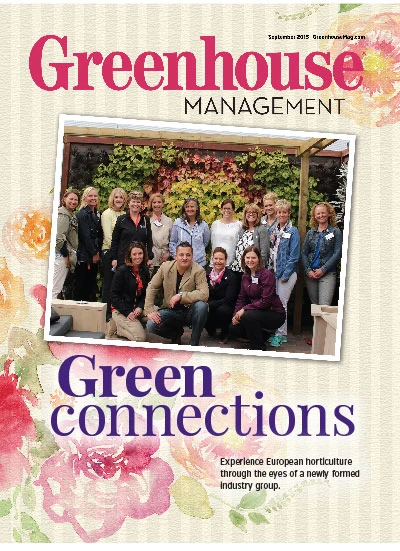 Several species of whiteflies are pests of greenhouse vegetable and ornamental crops. The most common are greenhouse whitefly (Trialeurodes vaporariorum), silverleaf whitefly (Bemisia argentifolii) and sweet potato whitefly (Bemisia tabaci). Whiteflies are so named because the adults look like tiny white flies that flit around plant foliage. They are not flies but sucking insects more closely related to scales, aphids and mealybugs. This is evident when you examine the nymphs, which are translucent scale-like discs on the underside of leaves.
Several species of whiteflies are pests of greenhouse vegetable and ornamental crops. The most common are greenhouse whitefly (Trialeurodes vaporariorum), silverleaf whitefly (Bemisia argentifolii) and sweet potato whitefly (Bemisia tabaci). Whiteflies are so named because the adults look like tiny white flies that flit around plant foliage. They are not flies but sucking insects more closely related to scales, aphids and mealybugs. This is evident when you examine the nymphs, which are translucent scale-like discs on the underside of leaves.
Most plant species can be fed on by some species of whitefly. Common ornamental hosts include poinsettia, gerbera, hibiscus, begonia and coleus. Whiteflies also feed on vegetable crops including cucumbers and herbs.
Whiteflies typically lay eggs on the undersides of leaves. Tiny crawlers hatch and settle on leaves and molt into immobile nymphs. They feed by inserting flexible hollow mouthparts into phloem tissue and sucking the sugary fluid. This results in light green or yellow chlorotic spots on the tops of leaves where nymphs are sucking out fluid below. Like other phloem feeders, whiteflies produce honeydew that leaves shiny patches on leaves where black, sooty mold can grow.
Whiteflies can persist in greenhouses year-round since they feed on so many plant species. They can also reproduce on many weeds inside or outside the greenhouse and on nearby field crops.
Monitoring
Monitor for adults using yellow sticky cards and by brushing plant foliage to watch for whiteflies that flit around and resettle. Scouting for nymphs is difficult and requires turning over leaves to look for the pests. Also look for shiny, sticky honeydew on leaves. Crops like poinsettia are prone to whitefly infestations, so scouting for adults, nymphs and damage is worthwhile.
Prevention
As with all pests, prevent whiteflies from entering your greenhouse by screening greenhouse doors and vents. Inspect new plants and cuttings for whitefly adults and nymphs before bringing them into a greenhouse. Sanitation is the next line of defense to reduce whitefly abundance and damage. Whiteflies will reproduce on weeds so be sure to remove weeds from the inside and outside of greenhouses. High temperatures and over-fertilizing makes whiteflies and other sucking pests develop faster. So maintain only the temperature and fertilizer necessary to maximize crop performance.
Biological treatment
here are several biological control agents available for whitefly management. Generalist predators like mirid bugs and lacewing larvae feed on many pest species including whiteflies and can help reduce pest pressure. The most common biological control agents for whiteflies are Encarsia and Eretmocerus parasitoids. These tiny wasps lay eggs inside or beneath whitefly nymphs. The wasp larvae then feed and develop within the nymph and emerge as an adult to kill more whiteflies. Pathogens like Beauveria bassiana are also good biological control options for whitefly management. Biological controls are best used preventively since they do not provide rapid suppression of large populations.
Conclusion
Many insecticides are available to include in your whitefly management program. Drenching with systemic insecticides can provide a baseline level of control. Remember that as plants grow they will be using up the insecticide in their tissue and in the soil. Thus, repeat drench applications as recommended on the label and after repotting to maintain efficacy. Foliar insecticides like insect growth regulators can also be used to clean up whitefly nymphs. Since whitefly nymphs are on the undersides of leaves and adults may fly outside of your spray area, assume you will not get them all. Continue monitoring and repeat applications as necessary. Rotate two or three products with different modes of action to reduce the development of insecticide resistance.
Steven D. Frank is Associate Professor and Extension Specialist at North Carolina State University. He conducts extension and research related to greenhouse pest management.

Explore the September 2015 Issue
Check out more from this issue and find your next story to read.
Latest from Greenhouse Management
- Anthura acquires Bromelia assets from Corn. Bak in Netherlands
- Top 10 stories for National Poinsettia Day
- Langendoen Mechanical hosts open house to showcase new greenhouse build
- Conor Foy joins EHR's national sales team
- Pantone announces its 2026 Color of the Year
- Syngenta granted federal registration for Trefinti nematicide/fungicide in ornamental market
- A legacy of influence
- HILA 2025 video highlights: John Gaydos of Proven Winners





